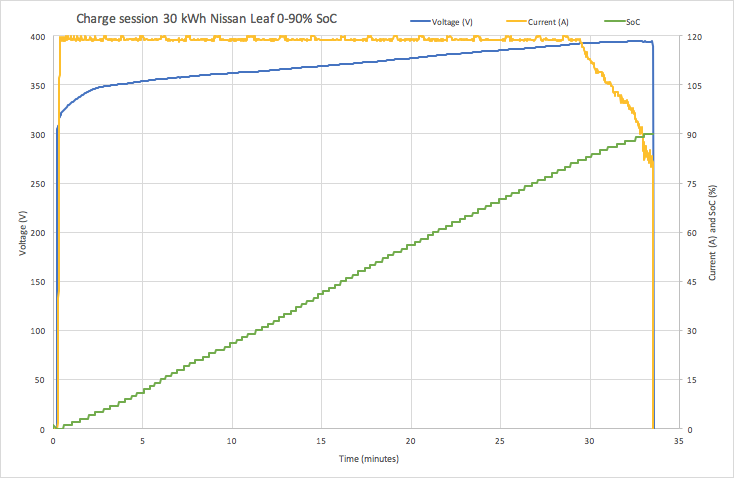Well, Jack at Bolt EV Blog delivered with some charts of DC charging on a Bolt:
Bolt EV Blog: DC Fast Charge data
Yeah, never hits 50 kW. Dropping below peak already at 50% SoC. Another big drop at 70% SoC. GM is probably being quite conservative. With this data, it means even with going to higher amperage, the Bolt likely sees less than 60 kW charging with 160 amp chargers... At the lowest SOC's, the voltage is quite low, so even at 160 amps at ~330 volts, that's 53 kW. A peak at ~350 volts x 160 amps = 56 kW. Taper off before 50% SOC, so unclear with higher amperage when exactly the taper would hit. It is possible that a 160 amp EVSE, if the internal wiring of the Bolt can handle it, would provide the benefit of charging at 50-55 kW at the lower parts of the battery SOC.
With such a taper at 50% SOC... the Bolt is dropping below 40 kW while the older Model S 60 with older firmware is still above 50 kW. This means at no time does the Bolt charge faster than the Bjorn's older Model S 60... they almost touch right at 70% SOC, but then the Bolt drops to under 25 kW while the Model S is still at just under 40 kW (over 100 amps). Looking at KmanAuto's videos, his older Model S 60 doesn't drop to 45 kW until about 60% SoC. Again, at 70%, they almost touch. Mind you, at 11% SOC, his Model S is charging above 100 kW.
This is quite puzzling for a NMC chemistry. But maybe they don't want the repeat of the Kia Soul EV's battery degradation... another data point came in on the Idaho National Lab AVT testing and it looks downright terrible. This will be interesting to watch as NMC chemistries attempt to get near Tesla/Panasonic's NCA's specific energy. The BMW i3's degradation levels look "normal" but that's with much older, less dense NMC.




